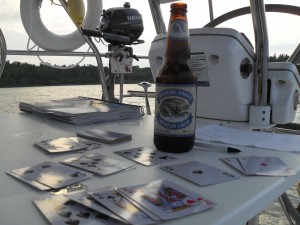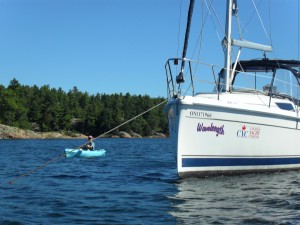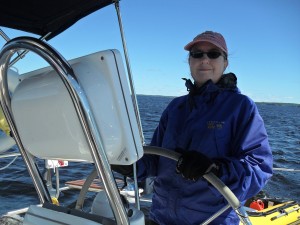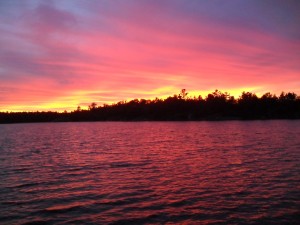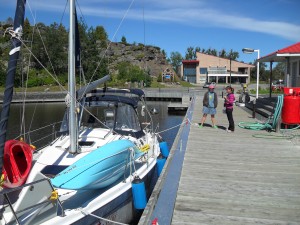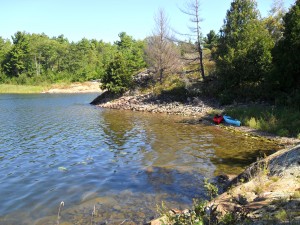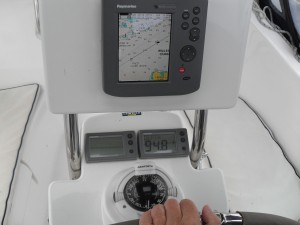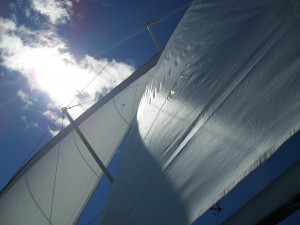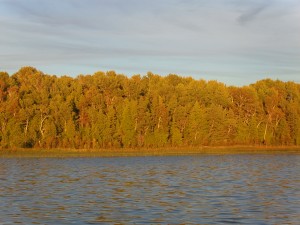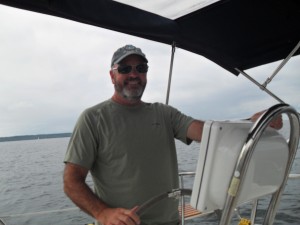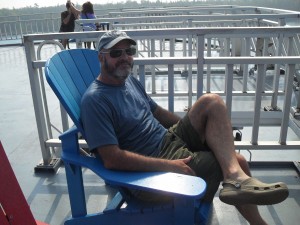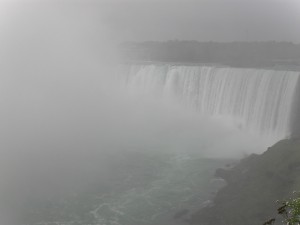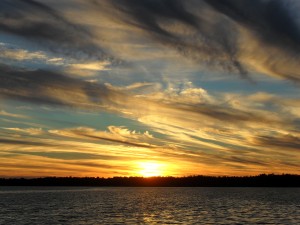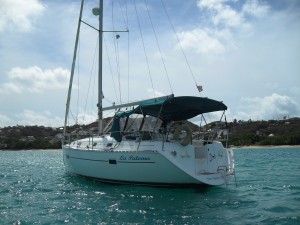Sailing Lake Huron
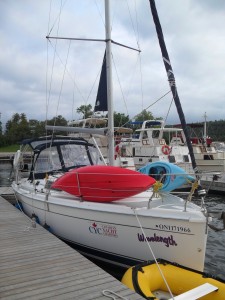 The 32-Foot Wavelength Preparing for Adventure
The 32-Foot Wavelength Preparing for Adventure
Just prior to the Great Boulder Flood, we left on vacation to do some sailing on Lake Huron, on the Canadian side, eh! Shelly did a lot of research and found that statistically, the North Channel of Huron is the place to find wind in the north this time of year. We also rented some kayaks to add to the fun.
On day 1 we sailed in good wind out of Gore Bay to Eagle Island and anchored in the north bay. The wind was out of the northwest and we were kind of exposed but it wasn’t terrible. At about 2:30 am that night I got up for some reason to check things out. We had originally anchored about 500 feet from shore in about 15 feet of water, which is fine for that area. Anchoring is supposed to be fantastic, the bottoms are generally clay or rock. Well, as I got up on deck in total blackness (it was overcast and there are no lights on shore), I noticed I could hear the leaves rattling in the trees on shore. That meant we were now about 20 feet from shore. For the second time we experienced the pleasures of anchor drag in the middle of the night. Previously it was in The Grenadines.
Shelly grabbed a flashlight. She had wisely noted their location when we checked out the boat. We were so close to the shoreline trees that we could illuminate them. The depth meter showed 3 feet. Given that we had a 4.5 foot keel draft, we were, in theory, on the ground. But we weren’t on the ground, probably because the depth meter was calibrated such that it read a shallower depth than was actually under the boat for safety reasons.

An Anchor
We got the engine started and Shelly pulled the anchor. BUT, since it was pitch black I had no reference to steer by. I tried using the chart plotter, which shows direction and speed, but it is a bit too crude for tight maneuvering and I didn’t want to motor into the shore. I was finally able to get the boat aimed away from shore and we reset the anchor once again. It held.
So what happened this time? We had a small-ish anchor and probably had it set in grass which was not solid enough for this anchor to grab. We originally dropped, set and watched the anchor as we always do and we didn’t drag. We couldn’t have done anything different except watch our position periodically (which we did for the rest of the trip). We didn’t have a problem after this incident.
The next day was short, had high wind. Not sure what the wind speed was because the Wavelength did not have an anemometer. We were doing 5 knots into the wind on reefed sails, which is fantastic speed. Got into Oak Bay and stayed there for a couple of nights. Never saw another boat in the bay.
Despite the general belief that Canada is a dry country, we did find some beer… Creemore was the local brand.
We tried out the kayaks in Oak Bay, Shelly is coming around the Wavelength in the pic above. There are no tides to speak of in the Great Lakes, but there is certainly a lot of current. We paddled upstream in a dead-end cove and were impressed by how much the wind drives the water. It took us about a half hour to get into the cove and about 10 minutes to get back to our boat.
The weather was mild. It really didn’t get too hot on the lake but at times it was definitely chilly, especially in the wind. Shelly is piloting with her gloves above.
Almost every sunset was spectacular!
We only docked once during the nine day trip for supplies and a pump-out in a town called Spanish (above). The channel going into Spanish is way shallow, they had just dredged it and there were many spots our depth meter read 4 or 5 feet. Despite warnings not to go in, we did anyway after seeing masts in their marina, meaning other sailboats had successfully navigated the channel. It was no problem. The dock lady saw me coming in wearing my winter hat and yelled “you’re making it look chilly with that touk!” Ah, those crazy Canadians!
We checked out a few islands for hiking, never found a trail. In the photo above is in Oak Bay. After this we went to anchor off of Aird Island. We set an anchor, no problem, but as we swung on the anchor we heard knocks, the boat was hitting a deadhead in the water. Turns out it wasn’t a Grateful Dead fan in this instance, but an underwater log or tree. Lots of them in this area. We moved and reset the anchor, no problem.
We had a couple of days of absolute calm and so had to motor many long hours to get to our next destination. Unfortunately we did not have an auto-helm, so someone had to steer the boat continuously. The above pic shows the instruments at the helm including the chart plotter. It’s basically a GPS navigator that uses nautical charts instead of land maps. Click on the photo to get a closeup. The two readouts below the chart plotter are the windspeed indicator (not working) and the depth meter showing 94.8 feet. Oh, and a compass.
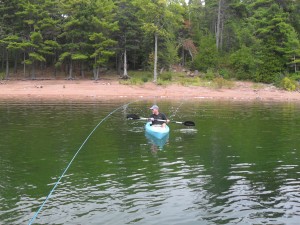 On day 7 we anchored at Coker Island. We also put in a stern tie, a line that anchors the back of the boat to shore. This keeps the boat from swinging all around an anchor and allows you to put many more boats in a small area, like parallel parking. In the above photo I am kayaking back from putting a line around a tree. I kept my pants on, I was a bit too modest to practice the ancient Canadian tradition of stern tying in your underwear.
On day 7 we anchored at Coker Island. We also put in a stern tie, a line that anchors the back of the boat to shore. This keeps the boat from swinging all around an anchor and allows you to put many more boats in a small area, like parallel parking. In the above photo I am kayaking back from putting a line around a tree. I kept my pants on, I was a bit too modest to practice the ancient Canadian tradition of stern tying in your underwear.
We only got a tiny bit of wind the next day, but we sailed on a reach for a while, above.
The last night we stayed on Clapperton Island with another great sunset illuminating the forested shoreline.
We experienced a lot of wind sailing back to Gore Bay the next day. All-in-all a good trip, very low key and uncrowded. We spent the rest of the trip touring the area. One cool thing was to take a ferry that cut off about 4 hours of driving.
In the photo above, I am relaxing on the top deck of the ferry, taking in the view. In the background you can see two Canadian women tussle over the last piece of back bacon on the boat. Those crazy Canadians!
That’s Niagara Falls above, but Boulder Falls was probably about this big at the time of this photo.
And for the finale:
Posted in Sailing by Mark with comments disabled.
St. Vincent and the Grenadines, Part 3
 Shelly On The Beach, Chatham Bay
Shelly On The Beach, Chatham Bay
After all the excitement of the first half of the trip, things settled down a bit. We had become familiar enough with the, ah, nuances, of the La Paloma to be comfortable in most of the sailing situations we would encounter.
 One of the cool things we saw at almost every island were these big, multi-mast sailing ships. Everything from three to five masts, some of them were cruise ships that had accommodations for maybe up to 100 people or more. The really big ships would anchor way out at the entrance of the bays and most of them would have their masts lit up at night. Also, I guess Pirates of the Caribbean was filmed on St. Vincent and one of the Gaff rigged ships used in the movie was anchored at Tobago Cays.
One of the cool things we saw at almost every island were these big, multi-mast sailing ships. Everything from three to five masts, some of them were cruise ships that had accommodations for maybe up to 100 people or more. The really big ships would anchor way out at the entrance of the bays and most of them would have their masts lit up at night. Also, I guess Pirates of the Caribbean was filmed on St. Vincent and one of the Gaff rigged ships used in the movie was anchored at Tobago Cays.
We also met some interesting people over the course of the trip. One family from New York had chartered a mono-hull and  went through the briefing the same day we did. They anchored near us in the Cays (actually too close to us) and invited us for happy hour one night. We also met a group of Canadians, eh! They were in the cat on the right. We met them at a lobster barbecue at Chatham Bay. They were having a good ‘ol time and invited us to sit with them for dinner. After dinner we were “treated” to live music that consisted of one guy singing reggae songs while strumming a painfully out-of-tune guitar. The next day we both sailed to Saline Bay on Mayreau Island where we were invited to their cat for happy hour. It was amazingly large and modern compared to our boat and cost about twice what we were paying. We prefer mono-hulls though, they can sail more directly into the wind.
went through the briefing the same day we did. They anchored near us in the Cays (actually too close to us) and invited us for happy hour one night. We also met a group of Canadians, eh! They were in the cat on the right. We met them at a lobster barbecue at Chatham Bay. They were having a good ‘ol time and invited us to sit with them for dinner. After dinner we were “treated” to live music that consisted of one guy singing reggae songs while strumming a painfully out-of-tune guitar. The next day we both sailed to Saline Bay on Mayreau Island where we were invited to their cat for happy hour. It was amazingly large and modern compared to our boat and cost about twice what we were paying. We prefer mono-hulls though, they can sail more directly into the wind.
 The most interesting couple had been living on their small, 34-foot sailboat for 7 years. In that time they had circumnavigated the world, among other things. Their boat was called the Coromandel. They were British and so between them had a bunch of experience prior to living on their boat, but they told us that sailing around the world is quite easy. You follow the trade winds that continuously blow in the same direction all around the globe.
The most interesting couple had been living on their small, 34-foot sailboat for 7 years. In that time they had circumnavigated the world, among other things. Their boat was called the Coromandel. They were British and so between them had a bunch of experience prior to living on their boat, but they told us that sailing around the world is quite easy. You follow the trade winds that continuously blow in the same direction all around the globe.
The last two days of sailing were tough. We sailed from Mayreau to Bequia, about 25 miles upwind, in one day. It was about 7 hours of having the boat heeled to one side while riding bumpy waves. The following day was only about two hours back to St. Vincent but the seas were of course a bit rougher in the Bequia Channel.
All-in-all a great trip. Our goal was to sail somewhere a bit more challenging than in the past an we got what we asked for. As a matter of fact, I think we’re going to have a difficult time tolerating winds less than 20 mph, they’ll seem much to wimpy!
Posted in Sailing by Mark with comments disabled.
St. Vincent and the Grenadines, Part 2
An Approaching Storm off the Port Bow
It turns out that day 1 was the most exciting single day of the trip, though the adventure was far from over. The next day we started out intending to make the long passage to Canuoan Island but as we started motoring out of the bay the engine started banging as it had the day before. We made the decision to call for a repair rather than risk losing the engine completely. This gave us a day to hang out and relax and it wasn’t really a problem as Shelly had built in some spare days into our schedule.
We hung out and did some snorkeling and waited for a local boat repair guy to show up. At some point in early afternoon a long, flat and beat-up old workboat approached with tall, gray-haired guy and a pint-sized mutt laying on the bottom. It was Robin, an old English guy who looked like he had slept on the beach for the last 20 years. He barely said hello and got straight down to the engine. He thought the engine mountings were loose and had to return later with the tools to tighten them up. No problem, we were around for the day anyway. He did his work later that evening and we spent our second night in Admiralty Bay.
 Got going early the next morning without incident. It was cloudy but the wind was steady. We motored out around the west point of Bequia where we saw this shipwreck on the left. It looked like a commercial boat had tried to cut between two cays, little islands off the west point where the water is quite shallow. The rust on the boat indicated the wreck had been there a while.
Got going early the next morning without incident. It was cloudy but the wind was steady. We motored out around the west point of Bequia where we saw this shipwreck on the left. It looked like a commercial boat had tried to cut between two cays, little islands off the west point where the water is quite shallow. The rust on the boat indicated the wreck had been there a while.
We navigated well clear of the point and headed south. This mean we pointed somewhat southeast as the current down here pushes you west and it’s fairly strong and steady. The wind was good and steady and the waves were only about 5 feet. Soon we were engulfed in a series of squalls. For those who haven’t experienced these, they basically look like approaching thunderstorms. On the ocean, however, these things come at you much faster than you think. They look relatively far away but then wham, they hit and throw you around if you are unprepared. The problem for a sailor is that, just as in a thunderstorm on land, the wind shifts wildly in speed and direction. It’s better to reef or take your sails in completely in these storms. These squalls only last a few minutes and dump a ton of rain on you, but then they’re gone.
The La Paloma was equipped with a radar and it turned out to be an excellent tool to determine when and where the storm would hit. We watched one approach us from behind, overtake us with rain and wind and then move off.
The passage to Canouan is about 20 miles and we sailed all the way. We anchored in Charleston bay and got some provisions in town.
 The next day we had a short sail to the Tobago Cays, a protected marine park consisting of several small islands surrounded by coral reefs. We anchored in this very popular preserve for a couple of days. The first thing we did was to reserve our place for a lobster barbecue dinner on the beach. A guy will come out to pick you up and bring you back to your boat after dinner. They do not catch the lobster in the park but bring it in from the surrounding area. Good stuff and the dinner was so large no one could possibly eat it all.
The next day we had a short sail to the Tobago Cays, a protected marine park consisting of several small islands surrounded by coral reefs. We anchored in this very popular preserve for a couple of days. The first thing we did was to reserve our place for a lobster barbecue dinner on the beach. A guy will come out to pick you up and bring you back to your boat after dinner. They do not catch the lobster in the park but bring it in from the surrounding area. Good stuff and the dinner was so large no one could possibly eat it all.
 The next day we motored our dinghy over to one of the little islands and hiked to the top for a great view (right). We then snorkeled around a bit just off shore. Here and over the whole trip we saw huge schools of psychedelic tropical fish, a three foot wide manta ray, lobster, turtles, sea snakes (!), sea urchins, fish that look like rocks, and lots of young, green coral. Every once in a while you would see this coral that is shaped like a planter, a little bowl that would have other things growing in it, very strange and beautiful. On shore we saw another strange site: the hindquarters of something trotting away that was about
The next day we motored our dinghy over to one of the little islands and hiked to the top for a great view (right). We then snorkeled around a bit just off shore. Here and over the whole trip we saw huge schools of psychedelic tropical fish, a three foot wide manta ray, lobster, turtles, sea snakes (!), sea urchins, fish that look like rocks, and lots of young, green coral. Every once in a while you would see this coral that is shaped like a planter, a little bowl that would have other things growing in it, very strange and beautiful. On shore we saw another strange site: the hindquarters of something trotting away that was about  the size of a cat but white with black rings. Shelly overheard a local tour guide say it was a white Iguana. A big one.
the size of a cat but white with black rings. Shelly overheard a local tour guide say it was a white Iguana. A big one.
Back at the La Paloma, I swam out to check our anchor (good) and investigate the sand bank that was about 100 yards off our starboard bow. I swam over to it and it and saw that it was a vast underwater sand plateau only about 4 feet deep. You could walk around on this thing that appeared to be in the middle of the ocean. A strange sight for a Colorado boy.
 As I mentioned earlier, the anchorage was fairly crowded, we were on one edge near the sand bank. The cats (catamarans) could anchor in much shallower water than we could so they could creep closer to the sand bank as you can see in the sunset pic on the left. We ended the day with dinner and drinks on board. Can’t eat that lobster every day. Well, maybe you could but even though it was half to 2/3rds the price of lobster here, it was still expensive.
As I mentioned earlier, the anchorage was fairly crowded, we were on one edge near the sand bank. The cats (catamarans) could anchor in much shallower water than we could so they could creep closer to the sand bank as you can see in the sunset pic on the left. We ended the day with dinner and drinks on board. Can’t eat that lobster every day. Well, maybe you could but even though it was half to 2/3rds the price of lobster here, it was still expensive.
 We watched another beautiful Carribean sunset out the back of our from the deck. Ok, let’s face it, every sunset was beautiful down there!
We watched another beautiful Carribean sunset out the back of our from the deck. Ok, let’s face it, every sunset was beautiful down there!
We left late the next morning on our way to Chatham Bay on Union Island. This would be a moderate sail, swinging around the north side of Mayreau Island and down around the south side of Union Island. This seemed to be a roundabout way to get to our destination but it was actually the shortest route possible. What appeared to be a direct route was blocked by underwater barrier reefs that we needed to avoid. On the way out we said goodbye to a little spit of sand off one of the islands (left) where dozens of sea turtles would swim with you as you snorkeled.
On the way out we said goodbye to a little spit of sand off one of the islands (left) where dozens of sea turtles would swim with you as you snorkeled.
Our water tanks were running low so we decided to stop at Clifton Harbor on Union Island to refill. It was on the way to Chatham Bay, which has no services. You come into a dock where they run a hose out to you and fill up on water, we needed about 60 gallons at this point. Seemed easy enough. Shelly maneuvered perfectly into the dock and we tied on, they ran a hose out and we filled up. In the meantime some guys said they would run into town and buy us a few groceries and get some ice. Though you have a fridge on the boat it can only be turned on while the engine is running, and that isn’t very often. You need ice to help keep it cold the rest of the time.
We finished up with the water and were just waiting for the guys to return with our groceries when a boat came in wanting water. The dock was small so they asked to raft to our boat. That means they would tie to the outside of our boat instead of the dock, a common technique when there isn’t much space. We said OK.
Well they came in way too fast, like a scud missle. We told them to veer off and try again. They almost collided with us at relatively high speed. Um, ok, so change of plans. We’ll be nice and leave the dock and anchor to wait for our groceries which should be by soon. We left the dock and dropped an anchor. Bad idea. Because this is an old harbor, there apparently is a bunch of old junk on the bottom. So we found that our anchor got hooked on something and we were stuck. The guidebook shows this area as a valid anchorage, but trust me, it is not.
Anyway, we ended up paying a guy an exorbitant amount to dive down and unhook our anchor. It was stuck probably 30 feet down. In the meantime our groceries showed up. We finally got away, in fact ran away from that harbor, with two expensive sailing courses: Where Not To Anchor 101, and How To Unhook Your Anchor 101. But the day wasn’t over yet…
We got out and put up sails in a good, stiff wind. At some point we did a controlled jibe. Though not taught to beginners, is a perfectly valid maneuver as long as you control the boom of the mainsail. We did that OK but the jib (front sail) got pushed around the front of fore stay and wrapped a couple of times. This is not good. Our sail looked something like below. For non-sailors, trust me, it is not supposed to look like this:

At the time we could not unwrap it because it was too windy, so we motored closer to the island to figure it out. And we did get it fixed fairly quickly. Another course passed, How To Untangle A Jib Sail 101.
We finally made it to Chatham Bay, a very peaceful and beautiful anchorage, below.
The last part of the story to come next in part 3.
Posted in Sailing by Mark with comments disabled.
Sailing St. Vincent and the Grenadines, Part 1
The La Paloma
Ok, I haven’t posted for a while but I’m finally catching up with this first part of our sailing trip around St. Vincent and the Grenadines. Shelly and I did a bareboat charter (just the two of us) and had some challenging sailing in the southern Caribbean.
We flew out of Denver just as one of the larger snowstorms of the year was developing. Landed in Grenada and stayed overnight. You remember Grenada, the little country that Reagan had the military invade in 1983. This small island must have been completely overwhelmed by that action and the point was made, like pushing in a thumb tack with a sledge hammer. Anyway, it was a beautiful place, what little we saw before island hopping to St. Vincent the next morning.
We had the next entire day to hang out in St. Vincent . We stayed at the Beachcombers Hotel right on the beach. Nice place with an outdoor bar where you could grab a beer and watch the sailboats cruise in what appeared to be a calm sea just offshore, which I am doing in the pic on the right. The local St. Vincent beer is called Hairoun, which happens to be the native Carib name for St. Vincent. It means “land of the blessed.” That might well be a true saying, but unfortunately they haven’t been blessed enough to bottle their beer in 12-ounce size. Each Hairoun was in an 8-ounce bottle. You have to order Presidente beer to get your 12-ounce size. And the price is about the same. Go figure. And truth be told, Presidente is better beer (disclaimer: Do not, under any circumstances, take my recommendations as to what makes a good beer. If you do, you will likely be severely disappointed and develop deep anger and resentment).
. We stayed at the Beachcombers Hotel right on the beach. Nice place with an outdoor bar where you could grab a beer and watch the sailboats cruise in what appeared to be a calm sea just offshore, which I am doing in the pic on the right. The local St. Vincent beer is called Hairoun, which happens to be the native Carib name for St. Vincent. It means “land of the blessed.” That might well be a true saying, but unfortunately they haven’t been blessed enough to bottle their beer in 12-ounce size. Each Hairoun was in an 8-ounce bottle. You have to order Presidente beer to get your 12-ounce size. And the price is about the same. Go figure. And truth be told, Presidente is better beer (disclaimer: Do not, under any circumstances, take my recommendations as to what makes a good beer. If you do, you will likely be severely disappointed and develop deep anger and resentment).
The next day proved to be an adventure. We showed up at the charter office around 9 am but the boat wasn’t ready. The jib sail (the one in front) was being repaired and the engine was having issues. They replaced the coolant pump. By the time we could get sailing it was almost 3 pm, pretty late. We needed to get to Bequia, the nearest island, which could take more than a couple of hours.
We discovered that our boat, the La Paloma, had a main sail that furled in and out of the mast. The usual rigging for the main sail on a mono-hull boat is to raise and lower the sail using a rope called a halyard, so when you want to sail you raise the mainsail and when you want to stop sailing you drop the main down to the boom. If you look at the diagram below, our sail rolled left and right into and out of the mast, while most mono-hulls have the main sail go up and down from the boom. This was new to us but it seemed way more convenient.

NOT! The last thing the charter guys said to us as we were leaving was that “sometimes the sail sticks” and you have to go up on deck to pull the sail out of the mast. What he meant was that it always gets stuck and you have to go out and heave mightily on the damn thing every time you unfurl it. We didn’t think much of it at the time, but it turned into a major difficulty. And keep in mind they had just made a last minute repair of the engine…
SO… We depart and get into some good wind and want the sails up. We try cranking the mainsail out of the mast and it jams up quite nicely. Yes, we did have to go out on deck and pull the thing out by hand. In the meantime the boat is rocking on the waves and the big sail is flapping, you had to be extra careful not to get pitched overboard. But we did get it out after much struggle and quite vocal raging. The waves are fairly high in the channel, as much as ten feet, and it’s generally choppy as we ride up and down. We also discover the wind is a bit higher than we are used to, it was pretty steadily 20+knots (22 mph) so we were moving fast as well.
It turned out that the conditions in the Bequia Channel were the most challenging of the trip, which is all fine and dandy except that this was our first hour of sailing and we were still getting the feel for the boat. As we approached the island of Bequia, the waves got a bit higher and the wind became gusty and variable in direction, making it extremely difficult. This is an effect of the channel and the island. Winds break up and gust around the island while in the same vicinity the ocean floor is rising from a thousand meter depth to a few hundred feet, causing the water to be choppy and wavy.
The sails are set based on the wind direction and when it starts the shift around faster than you can adjust the sails, the boat becomes more unstable. In those situations you generally reef the sails, meaning you make them smaller so the wind can’t push you as hard, or you take them in entirely. We reefed both the main and the jib but conditions got worse, waves were breaking over the railing and the boat became very difficult to control. This isn’t normally a big problem, the solution is to take in the sails completely, which stabilizes the boat, and motor in (all these sailboats have a motor as well as sails to get around). The trick is to get the sails down in the high wind while your boat is pitching around. You do this by turning on the diesel engine, engaging it and pointing the boat into the wind to take the force off the sails so you can take them down.
Well, the engine started just fine but when I engaged the propeller forward it began a periodic BANG… BANG… BANG that shook the entire boat and did not engage the propeller. This was the first time we had used the motor. Not good. Not good at all. I played around with the engagement lever for a minute and it started to work. I then pointed the boat into the wind and Shelly was able to get the sails in while big waves broke over the bow, soaking us with ocean water. I started to get seasick…
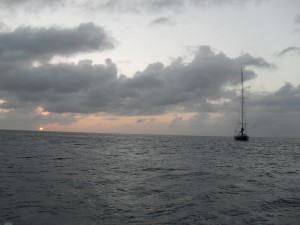 As soon as we rounded the point on Bequia it was calm and things got much better. We motored into Admiralty Bay and set our anchor. Because we got there relatively late, around 5 pm, the anchorage was rather full and we had to pick a spot that was a bit deeper and more windy than was ideal, but it seemed good enough. Anchoring conditions are actually very good on all these islands. We finally got a chance to relax, have a drink and fix dinner on board. We watched the sun set over the Caribbean sea, left. Note that there were many more boats around us than are shown in this pic but this was a nice view.
As soon as we rounded the point on Bequia it was calm and things got much better. We motored into Admiralty Bay and set our anchor. Because we got there relatively late, around 5 pm, the anchorage was rather full and we had to pick a spot that was a bit deeper and more windy than was ideal, but it seemed good enough. Anchoring conditions are actually very good on all these islands. We finally got a chance to relax, have a drink and fix dinner on board. We watched the sun set over the Caribbean sea, left. Note that there were many more boats around us than are shown in this pic but this was a nice view.
After dinner we remained on deck as it rapidly got dark. There is essentially no twilight near the equator. As soon as the sun drops below the horizon you’ve got about 15 minutes before it is completely dark. While sitting there I noticed we appeared to be much closer to the boat behind us than we were when we anchored. We watched it for a while and yes, we were definitely much closer. Our anchor was dragging, placing us dangerously close to another boat.
What was pushing us? The boat is affected by both wind and current. I suspect the major contributor was wind pushing us as we were in a stiff, steady breeze. Unfortunately we did not start dragging until it was completely dark. We were not dragging earlier as we always follow the standard procedure to watch our position for a while after anchoring to check.
We were not in a good situation because to fix this we had to reset the anchor and this involves maneuvering the boat, raising the anchor and dropping it somewhere else. There were boats anchored very close by, like within 100 feet, and moving around in the dark is dangerous. Boats are generally not lit well at night and there are anchor lines you can hit. But we had no choice and fortunately, we were able to raise the anchor, maneuver and reset without hitting anything. We sat on deck checking the line for about 45 minutes to make sure it was OK. It was. Throughout the night we would get up and check out position but there were no further problems.
THAT was day one. This is adventure!
More to come…
